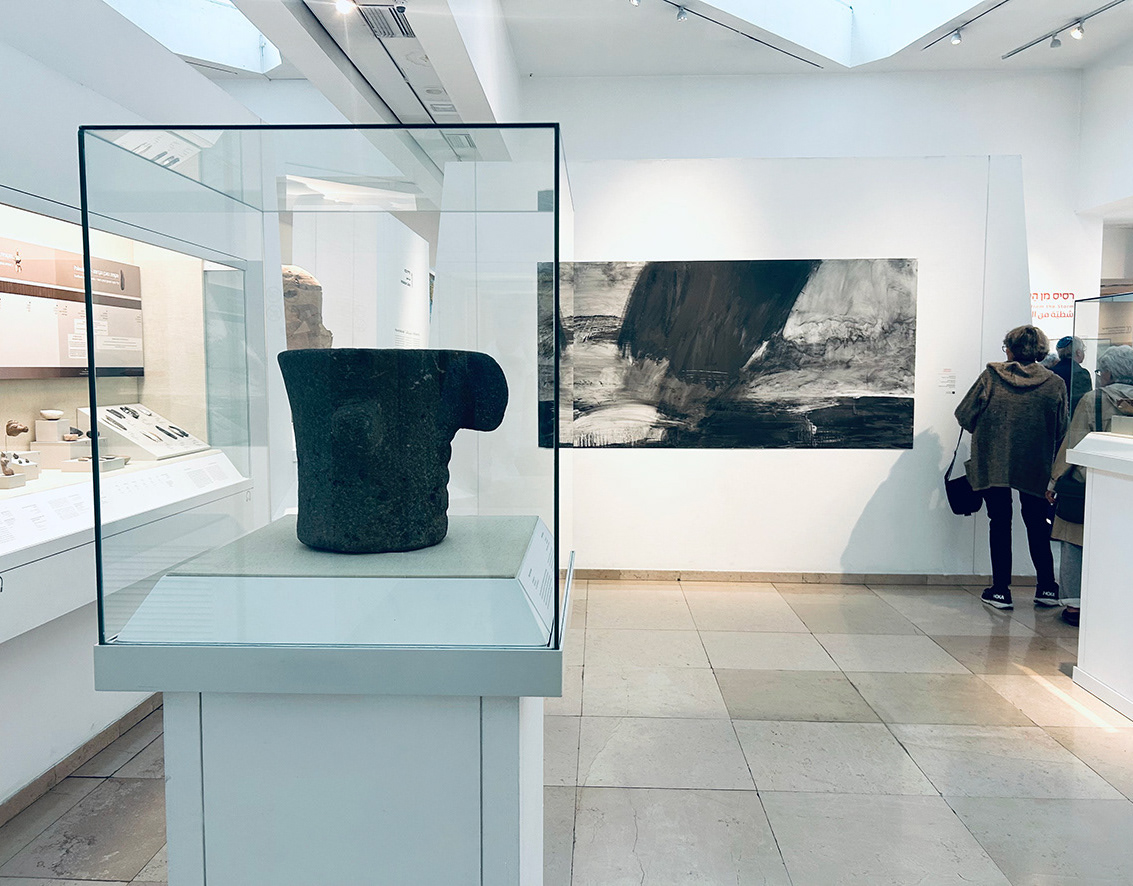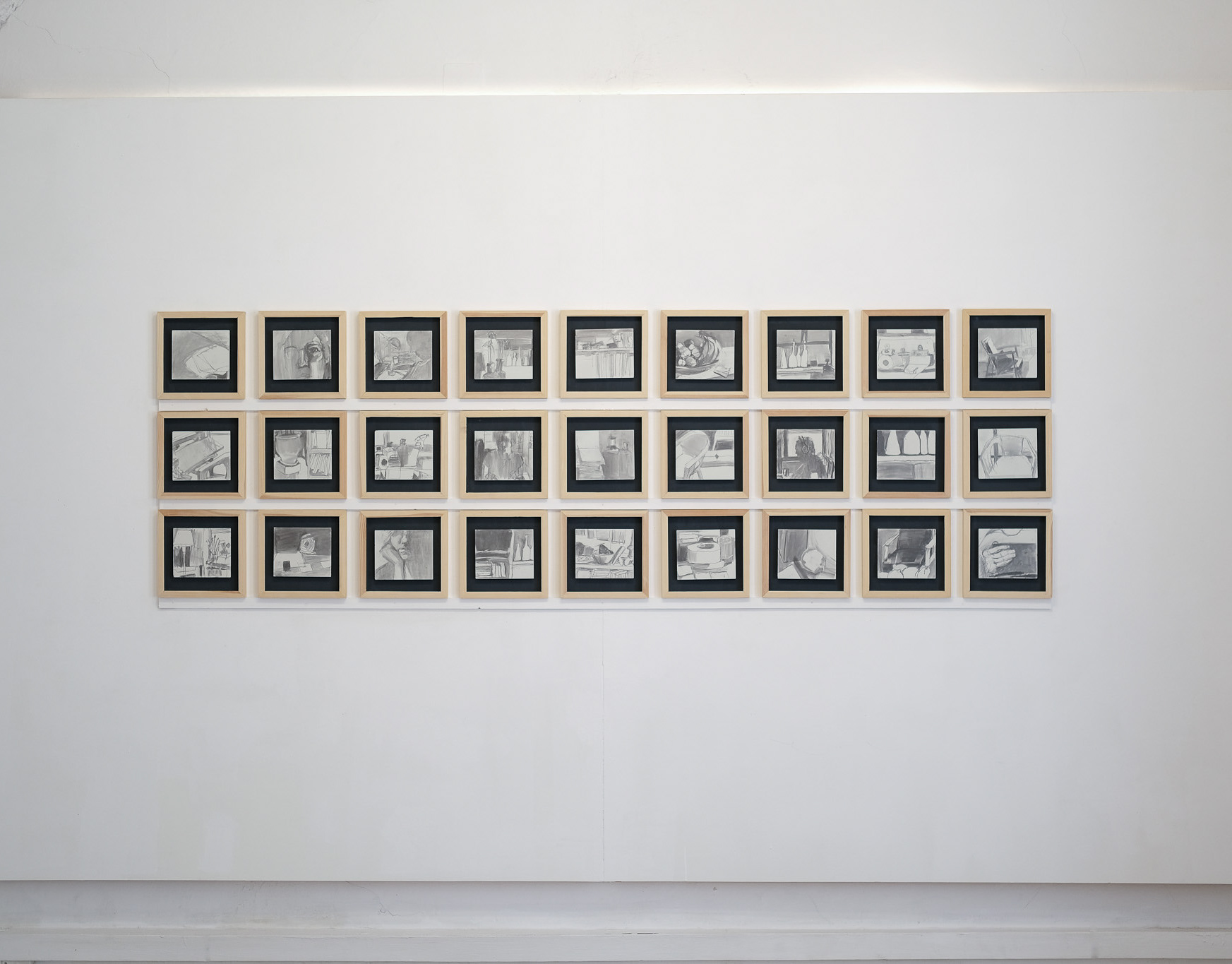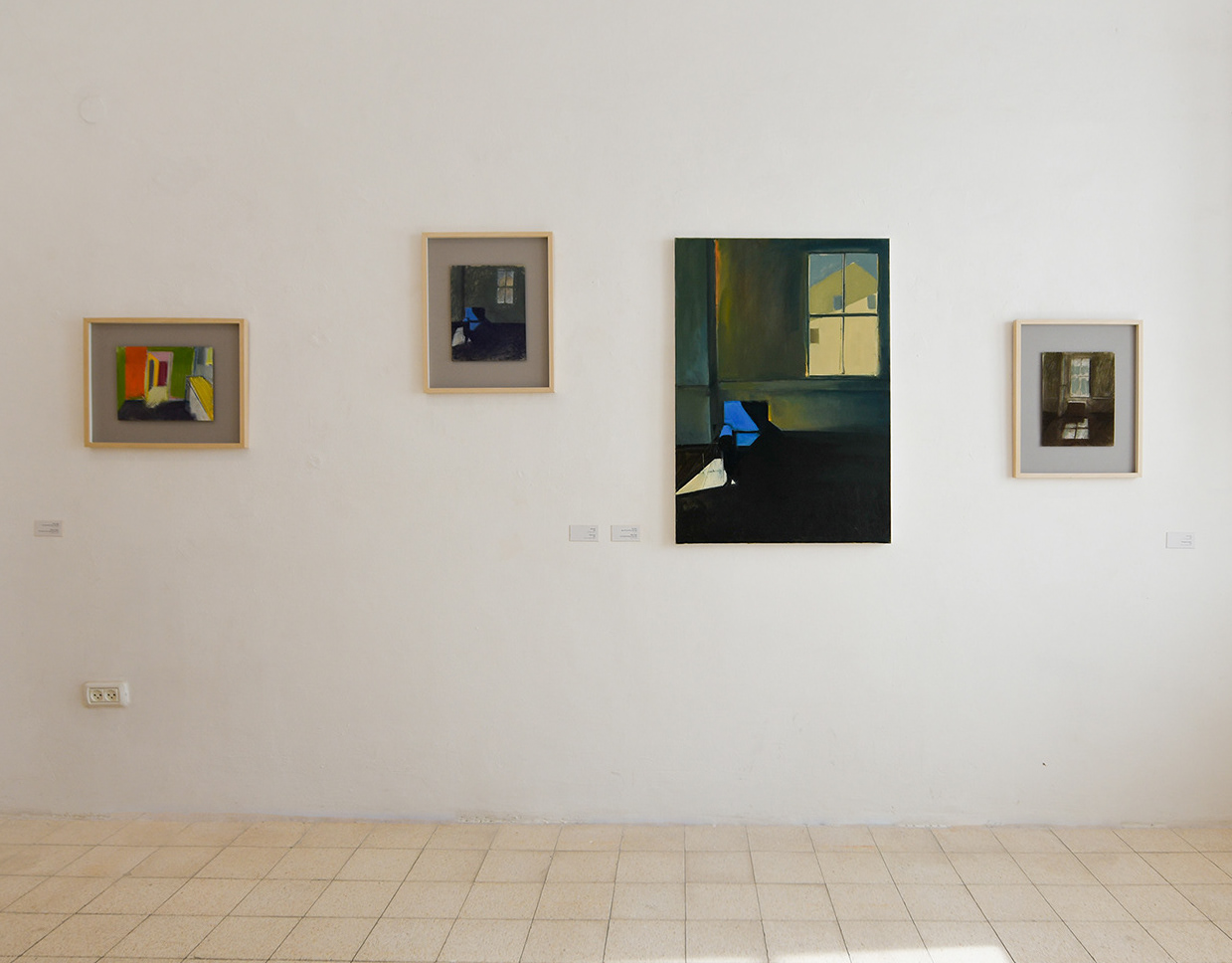Promise, 2020. Oil on canvas, 40x35 cm, Home/Studio, 2020. Graphite on panel, 11x13 cm each
SPATIAL ACTION - Group Exhibition
Curated and Writen by Dr. Nava T. Barazani
Agripas 12 Gallery and Marie Gallery, Jerusalem
September - November 2022
September - November 2022
המיית הבד הלבן עולה בעבודתה של יעל בוברמן-אטאס. בדיוקן עצמי בתנוחת כובסת היא לוכדת שתי התרחשויות המדברות זו עם זו. האחת היא פעולת הציירת המבקשת לסמן על מצע הציור הלבן והמואר התחלה חדשה, בעת שהמכחול הזקוף כמו מנסה להיעתר למלאכה ולהוביל את האמנית המתמסרת אליו במרחב העבודה. ההתרחשות השנייה יוצאת מתוך פרפרזה הפוכה לכובסות בהדפסים יפנים ולרוחצות של דגה, שכן דמות הדיוקן של בוברמן-אטאס משתוקקת לסמן הבטחה ואחיזה בזמן על גבי הלובן של המצע; ואילו הכובסות והרוחצות מבקשות למחוק כתמים ולהלבין עדויות מתוך המציאות. הדף הלבן מעלה תהיות אצל האמנית שאומרת: "ההבטחה, מה יהיה? מה הולך להיות? הכל פתוח והיצירה עוד לא נכתבה. ויחד עם זאת נקודת המפגש בין המכחול לבין הבד מעורפלת עדיין". אותו משטח נכסף ומואר המונח לפניה מדגיש מעשיית מרחב לוטה בערפל. התקווה באותה עמימות מתגלה במבטה של האמנית על הבד שכמו מבקש, למרות הלאות, לפלוש פנימה ולהתחבר לפעימת ההשראה. "להתבונן פירושו ליצור" כותבים דלז וגואטרי ומוסיפים: "מסתרי היצירה הסבילה, תחושה, התחושה ממלאת את מישור הקומפוזיציה ומתמלאת בעצמה בשעה שהיא מתמלאת במה שהיא מתבוננת בו [...]".
The work of art is the outcome, among others, of a relationship between an artist and a workspace. Spatial Action is the visual plot woven from the places in which the member artists of two art arenas in Jerusalem spend time and interact: the galleries Agripas 12 and Marie. The studio, domestic space, external spaces, or the links between interior and exterior, the physical and psychological, are the intertwining threads between spaces that form the fabric of the contemporary visual narrative of workspaces and actions.
And yet, “Art preserves, and is the only thing in the world that is preserved. It preserves and is preserved in itself…” Postmodern thinkers attempted to sever the artist from the artwork and described the work of art as “a paradoxical monument which does not commemorate a past, but rather, preserves itself in the absence of man.” According to this theory, the gestures of art are no longer dependent on the creative artist who determined and shaped it. We can also add that the work of art is “a ‘compound’ of ‘percepts’ and ‘affects’,” a “‘being’ of sensations,” standing independently, existing on its own.
We can continue to touch upon the theory of the “death of the author” that nullifies the clear relationship between signifier and signified. However, let us now focus on the methodology of search and research that changes with each artist as he or she transforms, processes, and makes something come into being. Spatial Action refers to the extraction of those very same moments in which artists distinguish elements from the world and from life, adding to them “a pure bloc of sensations.”
To this end, we shall discuss seeing as gesturing towards the world emanating from the body and embodying the action in space. According to Maurice Merleau-Ponty, the ability to see is the capacity to be in the world. This makes the necessity for visual openness even more acute in order to create involvement in the world. Beyond the eye looking outward to the field of vision, there is a connection between the eye and the movement of the human body. This movement breathes life into renewed intersections and into the enigmatic link between things. In other words, the body constitutes “an intertwining of vision and movement” which makes a transition into concreteness and action like the ripening of a fruit coming into maturity. The world is not an external representation which artists see, but the artists themselves are born into the world, and therefore are part of and intertwined with the elements defining the world. Thus, the artwork, made by the artist who moves bodily through the texture of the world, enables the existence of what seems invisible through “profane viewing.”
Since the early 1960s, a revolution has taken place in the definition of the artist’s studio, in response to sociocultural and political changes, as well as shifting critical contexts. Since the margins of the studio space have been expropriated and deconstructed, the closed, isolated artist’s studio has been perceived as anachronism, a remnant of romanticism. However, despite the emptying out of meaning from the artist’s actions in the studio as a ritual act, the studio as a concept has not disappeared. In the postmodern era, artists’ studios have not ceased production, often acting as mediating, hybrid spaces for radical experiments attempting to forge connections between art and society in a constantly changing reality.
The contemporary perception of the ideal artist’s studio is that it is a changing space enabling work in many different spaces, both concrete and virtual, in varying time frames. It is seen as a transdisciplinary model of observation of, and working with, the external world. The artist may work in an isolated room or perform actions in public spaces such as cafés, parks, or trains, wandering through the city, or through actions performed simultaneously in several locations or on several continents.
Michel de Certeau wrote that every narrative is a spatial story - the story of a journey - and that our spatial narratives organize places, link them, and create routes and context-specific performances. He draws a parallel between “story” and “memory” and the attempt to understand a specific event, to make the marks of the past speak and be revived into the present. The reporting is not precise, since the narrative of the journey depends on the context, and is in constant movement. De Certeau, who negates permanent traces or predetermined borders that dilute the practices of everyday life, searches for routes and actions to mark the space as “trees of gestures” in movement.
And yet, “Art preserves, and is the only thing in the world that is preserved. It preserves and is preserved in itself…” Postmodern thinkers attempted to sever the artist from the artwork and described the work of art as “a paradoxical monument which does not commemorate a past, but rather, preserves itself in the absence of man.” According to this theory, the gestures of art are no longer dependent on the creative artist who determined and shaped it. We can also add that the work of art is “a ‘compound’ of ‘percepts’ and ‘affects’,” a “‘being’ of sensations,” standing independently, existing on its own.
We can continue to touch upon the theory of the “death of the author” that nullifies the clear relationship between signifier and signified. However, let us now focus on the methodology of search and research that changes with each artist as he or she transforms, processes, and makes something come into being. Spatial Action refers to the extraction of those very same moments in which artists distinguish elements from the world and from life, adding to them “a pure bloc of sensations.”
To this end, we shall discuss seeing as gesturing towards the world emanating from the body and embodying the action in space. According to Maurice Merleau-Ponty, the ability to see is the capacity to be in the world. This makes the necessity for visual openness even more acute in order to create involvement in the world. Beyond the eye looking outward to the field of vision, there is a connection between the eye and the movement of the human body. This movement breathes life into renewed intersections and into the enigmatic link between things. In other words, the body constitutes “an intertwining of vision and movement” which makes a transition into concreteness and action like the ripening of a fruit coming into maturity. The world is not an external representation which artists see, but the artists themselves are born into the world, and therefore are part of and intertwined with the elements defining the world. Thus, the artwork, made by the artist who moves bodily through the texture of the world, enables the existence of what seems invisible through “profane viewing.”
Since the early 1960s, a revolution has taken place in the definition of the artist’s studio, in response to sociocultural and political changes, as well as shifting critical contexts. Since the margins of the studio space have been expropriated and deconstructed, the closed, isolated artist’s studio has been perceived as anachronism, a remnant of romanticism. However, despite the emptying out of meaning from the artist’s actions in the studio as a ritual act, the studio as a concept has not disappeared. In the postmodern era, artists’ studios have not ceased production, often acting as mediating, hybrid spaces for radical experiments attempting to forge connections between art and society in a constantly changing reality.
The contemporary perception of the ideal artist’s studio is that it is a changing space enabling work in many different spaces, both concrete and virtual, in varying time frames. It is seen as a transdisciplinary model of observation of, and working with, the external world. The artist may work in an isolated room or perform actions in public spaces such as cafés, parks, or trains, wandering through the city, or through actions performed simultaneously in several locations or on several continents.
Michel de Certeau wrote that every narrative is a spatial story - the story of a journey - and that our spatial narratives organize places, link them, and create routes and context-specific performances. He draws a parallel between “story” and “memory” and the attempt to understand a specific event, to make the marks of the past speak and be revived into the present. The reporting is not precise, since the narrative of the journey depends on the context, and is in constant movement. De Certeau, who negates permanent traces or predetermined borders that dilute the practices of everyday life, searches for routes and actions to mark the space as “trees of gestures” in movement.
Borrowing this concept, we can say that the works in the current exhibition expand the practice of everyday life, relating narratives about actions in space, marking out mobile routes that sometimes depend on intersecting contexts.
The different views of space by the exhibiting artists form an encounter and a play between perspectives. The sights leave their imprint, and the act of making art enables the artists to imbue them with life. Deleuze and Guattari stated that “Sometimes it is necessary to lie down on the earth, like the painter does also, in order to get to the ‘motif,’ that is to say, the percept. Percepts can be telescopic or microscopic, giving characters and landscapes giant dimensions as if they were swollen by a life that no lived perceptions can attain.”
Artists are among the first to distinguish events and capture busy, seemingly tiny details of events. Within the conscious and unconscious expanses of their work, the artists of the two galleries delineate and superimpose compositional lines over chaos. Out of the dense network of interactions and processes, the space shatters into perspectives. Sometimes these perspectives cross, as if on bridges, unsure of the way. They may stop in place for a moment before moving on, leaving traces of the transition to enrich it with actions and leave the language of sensations to the ears of the future.
The different views of space by the exhibiting artists form an encounter and a play between perspectives. The sights leave their imprint, and the act of making art enables the artists to imbue them with life. Deleuze and Guattari stated that “Sometimes it is necessary to lie down on the earth, like the painter does also, in order to get to the ‘motif,’ that is to say, the percept. Percepts can be telescopic or microscopic, giving characters and landscapes giant dimensions as if they were swollen by a life that no lived perceptions can attain.”
Artists are among the first to distinguish events and capture busy, seemingly tiny details of events. Within the conscious and unconscious expanses of their work, the artists of the two galleries delineate and superimpose compositional lines over chaos. Out of the dense network of interactions and processes, the space shatters into perspectives. Sometimes these perspectives cross, as if on bridges, unsure of the way. They may stop in place for a moment before moving on, leaving traces of the transition to enrich it with actions and leave the language of sensations to the ears of the future.




